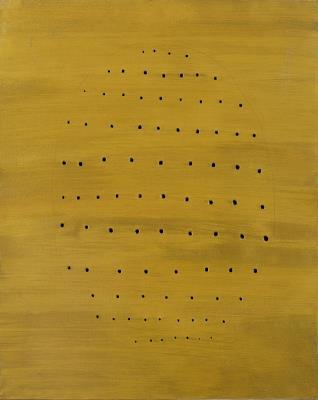Lucio Fontana *

(Rosario di Santa Fe, Argentina 1899–1968 Comabbio)
Concetto spaziale, 1966, signed; signed and titled on the reverse, oil and pencil on canvas, gold, 81 x 65 cm, framed
This work is registered in the Fondazione Lucio Fontana, Milan
Provenance:
Galleria Ferrari, Verona
Vittorio Zennaro Collection, Genoa
Galleria La Bertesca, Genoa
Nicola Giuliani Collection, Milan
Sale Sotheby’s Milan, 26 May 2005, lot 303
Tornabuoni Arte, Florence
European Private Collection
Exhibited:
Venice, Artempo. Where Times Becomes Art, Palazzo Fortuny, June-October 2007, exh. cat. p. 74, no. 33 with ill.
Paris, Lucio Fontana, Tornabuoni Art, October-November 2009
London, Tornabuoni Art, October-December 2015, p. 143, with ill.
Literature:
E. Crispolti (ed.), L. Fontana, Catalogue raisonné des peintures, sculptures et environnements spatiaux. La Conaissance, Bruxelles, 1974, vol. II, pp. 146–147, with ill.
E. Crispolti (ed.), Fontana. Catalogo generale. Electa, Milan 1986, vol. II, p. 504, no. 66 B 12 with ill.
E. Crispolti (ed.), Lucio Fontana. Catalogo ragionato di sculture, dipinti, ambientazioni, Skira, Milan 2006, vol. II, pp. 692–693, no. 66 B 12 with ill.
Note:
On the front the work is signed in pencil twice, once at the bottom and once at the top. On the back there is the directional arrow in the opposite direction to the image reproduced in the catalogue raisonné.
“That phenomenal gold, the colour of the material, a drop of reflective light, makes a connection to a higher spiritual plane. Every work which is golden in colour radiates a magical and transcendental aura (…)
R. Siligato, Simbolismo e Scienza nella luce di Fontana, Milan, 1998
Lucio Fontana’s work emerged at a time of enormous challenges and ideological contradictions, but also of pivotal technological discoveries and innovations. The Second World War had just ended and the Cold War, with its nuclear threat, loomed. It was in this context of a world in ashes waiting to be rebuilt – coupled with a faith in progress and technology – that Fontana developed Spatialism as an artistic concept.
From the outset, his approach centred on conceiving space in a new way. Works in this vein aimed to renew and revive the artistic idiom, adapting it to the achievements of science and the general progress of mankind. Art would no longer be constrained by the limitations of canvas and matter; it would transcend boundaries, open itself up to the unknown.
Fontana created his first spatial concepts, or Concetti Spaziali, in 1949. The works are characterised by the presence of small holes, cavities, sometimes also slits and larger tears introduced into the material with his famous punzón. The slashing and puncturing radically disrupts the plane of traditional painting in an apparently iconoclastic gesture, when in fact it is the result of a long, deliberate process that effectively banishes the element of chance. As a result, the act, which could be described as spiritual and reflective, bears no resemblance to the modus operandi of contemporary movements such as Abstract Expressionism or certain strains of Informalism; it has nothing of their vehemence. And yet it also manages to liberate the artform from a centuries-old tradition that kept the canvas to a strict regime of two-dimensional flatness. Fontana’s puncturing of the surface sparks a dynamic interaction between the artwork and the viewer, but first and foremost between the artwork and its surroundings.
These are pieces created during the mature period of the Italian-Argentine painter, but above all during the years of the “Space Race” between the United States and the Soviet Union. The Concetto Spaziale seen here was executed five years after the initial space adventures of the Soviet cosmonaut Yuri Gagarin and just three years before the moon landing, at a truly unique time in human history. The work shows the artist’s enthusiasm for this new way forward – for the breakthrough into the infinity of space.
Another key aspect lies in Fontana’s chosen colour scheme: ducat gold. Many cultures have long associated the colour with holiness, incorruptibility and immortality; it is synonymous with divine light and transcendence. On the one hand, the canvas presents itself to the viewer as a secular altarpiece; on the other, the rhythmically arranged holes seem to follow an almost mathematical pattern, harmoniously expanding and widening towards the centre. It is as if Fontana’s Concetto Spaziale were beckoning us to a new, otherworldly dimension – and beyond, to the unexplored future.
Esperto: Alessandro Rizzi
 Alessandro Rizzi
Alessandro Rizzi
+39-02-303 52 41
alessandro.rizzi@dorotheum.it
24.05.2023 - 18:00
- Stima:
-
EUR 600.000,- a EUR 900.000,-
Lucio Fontana *
(Rosario di Santa Fe, Argentina 1899–1968 Comabbio)
Concetto spaziale, 1966, signed; signed and titled on the reverse, oil and pencil on canvas, gold, 81 x 65 cm, framed
This work is registered in the Fondazione Lucio Fontana, Milan
Provenance:
Galleria Ferrari, Verona
Vittorio Zennaro Collection, Genoa
Galleria La Bertesca, Genoa
Nicola Giuliani Collection, Milan
Sale Sotheby’s Milan, 26 May 2005, lot 303
Tornabuoni Arte, Florence
European Private Collection
Exhibited:
Venice, Artempo. Where Times Becomes Art, Palazzo Fortuny, June-October 2007, exh. cat. p. 74, no. 33 with ill.
Paris, Lucio Fontana, Tornabuoni Art, October-November 2009
London, Tornabuoni Art, October-December 2015, p. 143, with ill.
Literature:
E. Crispolti (ed.), L. Fontana, Catalogue raisonné des peintures, sculptures et environnements spatiaux. La Conaissance, Bruxelles, 1974, vol. II, pp. 146–147, with ill.
E. Crispolti (ed.), Fontana. Catalogo generale. Electa, Milan 1986, vol. II, p. 504, no. 66 B 12 with ill.
E. Crispolti (ed.), Lucio Fontana. Catalogo ragionato di sculture, dipinti, ambientazioni, Skira, Milan 2006, vol. II, pp. 692–693, no. 66 B 12 with ill.
Note:
On the front the work is signed in pencil twice, once at the bottom and once at the top. On the back there is the directional arrow in the opposite direction to the image reproduced in the catalogue raisonné.
“That phenomenal gold, the colour of the material, a drop of reflective light, makes a connection to a higher spiritual plane. Every work which is golden in colour radiates a magical and transcendental aura (…)
R. Siligato, Simbolismo e Scienza nella luce di Fontana, Milan, 1998
Lucio Fontana’s work emerged at a time of enormous challenges and ideological contradictions, but also of pivotal technological discoveries and innovations. The Second World War had just ended and the Cold War, with its nuclear threat, loomed. It was in this context of a world in ashes waiting to be rebuilt – coupled with a faith in progress and technology – that Fontana developed Spatialism as an artistic concept.
From the outset, his approach centred on conceiving space in a new way. Works in this vein aimed to renew and revive the artistic idiom, adapting it to the achievements of science and the general progress of mankind. Art would no longer be constrained by the limitations of canvas and matter; it would transcend boundaries, open itself up to the unknown.
Fontana created his first spatial concepts, or Concetti Spaziali, in 1949. The works are characterised by the presence of small holes, cavities, sometimes also slits and larger tears introduced into the material with his famous punzón. The slashing and puncturing radically disrupts the plane of traditional painting in an apparently iconoclastic gesture, when in fact it is the result of a long, deliberate process that effectively banishes the element of chance. As a result, the act, which could be described as spiritual and reflective, bears no resemblance to the modus operandi of contemporary movements such as Abstract Expressionism or certain strains of Informalism; it has nothing of their vehemence. And yet it also manages to liberate the artform from a centuries-old tradition that kept the canvas to a strict regime of two-dimensional flatness. Fontana’s puncturing of the surface sparks a dynamic interaction between the artwork and the viewer, but first and foremost between the artwork and its surroundings.
These are pieces created during the mature period of the Italian-Argentine painter, but above all during the years of the “Space Race” between the United States and the Soviet Union. The Concetto Spaziale seen here was executed five years after the initial space adventures of the Soviet cosmonaut Yuri Gagarin and just three years before the moon landing, at a truly unique time in human history. The work shows the artist’s enthusiasm for this new way forward – for the breakthrough into the infinity of space.
Another key aspect lies in Fontana’s chosen colour scheme: ducat gold. Many cultures have long associated the colour with holiness, incorruptibility and immortality; it is synonymous with divine light and transcendence. On the one hand, the canvas presents itself to the viewer as a secular altarpiece; on the other, the rhythmically arranged holes seem to follow an almost mathematical pattern, harmoniously expanding and widening towards the centre. It is as if Fontana’s Concetto Spaziale were beckoning us to a new, otherworldly dimension – and beyond, to the unexplored future.
Esperto: Alessandro Rizzi
 Alessandro Rizzi
Alessandro Rizzi
+39-02-303 52 41
alessandro.rizzi@dorotheum.it
|
Hotline dell'acquirente
lun-ven: 10.00 - 17.00
kundendienst@dorotheum.at +43 1 515 60 200 |
| Asta: | Arte contemporanea I |
| Tipo d'asta: | Asta in sala con Live Bidding |
| Data: | 24.05.2023 - 18:00 |
| Luogo dell'asta: | Wien | Palais Dorotheum |
| Esposizione: | 13.05. - 24.05.2023 |
